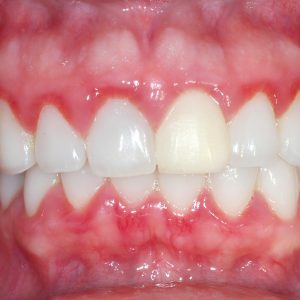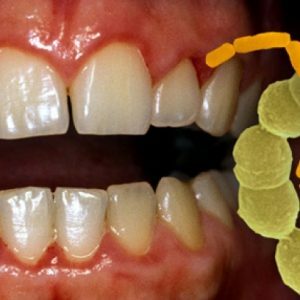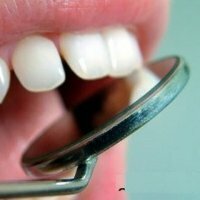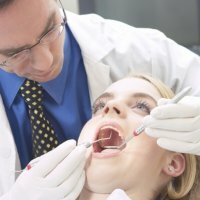Gingivitis - Symptoms, Classification and Treatment
 Gingivitis is an inflammatory process localized in the gums.The disease has pronounced symptoms, with timely diagnosis and treatment measures taken, a complete cure for the pathology is entirely possible.
Gingivitis is an inflammatory process localized in the gums.The disease has pronounced symptoms, with timely diagnosis and treatment measures taken, a complete cure for the pathology is entirely possible.
Causes of gingivitis development
The main cause of the development of the inflammatory process in the oral cavity is the dental plaque of the adhesive structure.It is able to accumulate along the edge of the gums - these places almost never fall under the toothbrush when carrying out hygienic procedures, and remaining on soft tissues it turns into tartar exactly after 3 days.
Doctors identify several factors that can trigger this process:
- adolescence, menopause and menopause in a woman - the body undergoes a powerful hormonal adjustment, which in some cases can lead to swelling of the soft tissues of the oral cavity, which makes it impossibleTo carry out a full-fledged cleaning of teeth and gums from plaque;
- long-term therapy with antibacterial drugs( antibiotics) - these drugs can cause gingival hyperplasia;
- low level of immunity.
Very high risk of developing when exposed to external factors on soft tissues of the oral cavity - for example, burns, trauma, aggressive chemicals.In these cases, wound surfaces with a clear localization are formed on the gums, which are an ideal medium for growth and reproduction of pathogenic microorganisms.
 Often diagnosed with gingivitis in children - the immune system in them is at the stage of strengthening, cleaning teeth is ineptly, so often injured gums.In childhood, the inflammatory disease under consideration can develop against the background of growth / eruption of the teeth - again because of the trauma of soft tissues.
Often diagnosed with gingivitis in children - the immune system in them is at the stage of strengthening, cleaning teeth is ineptly, so often injured gums.In childhood, the inflammatory disease under consideration can develop against the background of growth / eruption of the teeth - again because of the trauma of soft tissues.
Note : the risk group for gingivitis includes smokers and people who are overweight - this pathology never arises "from scratch," it is secondary.
Types of gingivitis and their clinical picture
This inflammatory disease of the oral cavity proceeds without disturbance of the dental joint, and more often localized gingivitis is diagnosed when a certain part of the soft tissue is damaged. Dentists classify gingivitis as follows:
- Catarrhal gingivitis.Patients notice increased sensitivity of the gums to air temperature changes, soft tissues have a pronounced pink color, are slightly edematous, and non-intensive pain syndrome may appear.
- Hypertrophic gingivitis.There is soreness of the soft tissues of the oral cavity, on the gums grow "papillae", which eventually cover almost the entire tooth. Please note : due to such an increase in soft tissues, cleaning the teeth becomes an impossible procedure, the patients stop caring for the oral cavity, which invariably leads to the appearance of multiple caries.
- Chronic.It flows almost without symptoms, for a long time the patient does not present any complaints at all, the only thing that draws attention to is puffiness of the gums, their gradual build-up on the teeth and slight bleeding.
- Ulcerative necrotic gingivitis.On the surface of the gums localized ulcerated areas are found, the soft tissue becomes very painful, and a fetid smell appears from the mouth. Note : only with this type of gingivitis, the clinical picture of the disease will be burdened by a general poor state of health: fever, weakness, nausea, fatigue.
Symptoms of gingivitis in children and adults
The main symptoms of this pathological process in the soft tissues of the oral cavity are as follows:
- soreness of gums - first this syndrome appears only when pressing on the tissue, then it becomes problematic to brush your teeth, with progressive gingivitis, the patient refuses solid food precisely because of pain;
- bad breath - this is due to the accumulation of putrefactive bacteria in the oral cavity;
- increased sensitivity of gums - a reaction to taking acidic, hot or ice food becomes acute pain.
Note : in dentistry, also the atrophic appearance of gingivitis is distinguished - soft tissues lose their tone and decrease in size, exposing the tooth cervix.But this condition is considered borderline between the usual inflammation of the gums and periodontitis.
Treatment of gingivitis
The diagnosis of the inflammatory disease of the oral cavity is quite simple - this can be done by the patient himself, without resorting to a dentist. Treatment of the same inflammation consists in observing the following rules:
- the doctor should clean the teeth and gums from plaque, tartar;
- the patient receives recommendations for the proper cleaning of the oral cavity with the use of dental floss;
- it is necessary to pass a course of reception immunomoduljatorov - resistance of an organism in relation to pathogenic microorganisms should be at a high level.
A brief outline of the treatment of gingivitis in the dentist's office is shown in the video review:
Treatment of gingivitis with folk remedies
The very effective treatment of gingivitis will be based on folk recipes - medicinal plants have all the healing properties that will help to quickly and permanently get rid of gingivitis. These include:
- Decoction of oak bark.You need to take a tablespoon of dried oak bark( sold in pharmacies) and pour a glass of water.Then put the mixture on a water bath and cook for at least 20 minutes from the boiling point.After the end of the process, you need to add more water to the broth so that the initial amount( glass) is obtained.Rinse the resulting decoction of the mouth cavity at least 3 times a day until the disappearance of symptoms of gingivitis.
- Wine broth of cornel bark.Dogwood is a fruit tree that grows in the south, but the bark of this plant can be purchased at pharmacies.You need to take a tablespoon of chopped raw materials, pour a glass of red dry wine and bring to a boil on the smallest possible fire.Cook the broth for 5 minutes, then add citric acid( at the tip of the knife) and the same amount of alum.The resulting drug is intended for rinsing the oral cavity, but it should be done only before eating.
- Coffee beans.Take coffee beans, fry them in a dry frying pan and rub with a blender or a meat grinder into a fine fraction.The resulting mixture is mixed with sugar powder in a ratio of 1: 1 and treat it with the gum.To do this you need a toothbrush with a soft pile and not more than 2 times a day.
- Tincture of arnica.In the pharmacy you need to buy a ready tincture of arnica and dilute in the proportion of 10 ml arnica and 150 ml of plain water.The resulting medicine can rinse the mouth as often as possible( at least every 30 minutes).
 Gingivitis is considered a fairly simple disease, and many do not pay attention to it, guided by the well-known principle of "self-will pass."But gingivitis can cause the development of complications such as periodontitis - this process of destruction of soft tissues invariably leads to tooth loss.Therefore, it is necessary not only to observe preventive measures in relation to the development of gingivitis( thorough cleaning of the oral cavity, regular examinations at dentists), but also to fully treat the already developed inflammatory process in the soft tissues of the oral cavity.
Gingivitis is considered a fairly simple disease, and many do not pay attention to it, guided by the well-known principle of "self-will pass."But gingivitis can cause the development of complications such as periodontitis - this process of destruction of soft tissues invariably leads to tooth loss.Therefore, it is necessary not only to observe preventive measures in relation to the development of gingivitis( thorough cleaning of the oral cavity, regular examinations at dentists), but also to fully treat the already developed inflammatory process in the soft tissues of the oral cavity.
About the prevention of gingivitis tells the dentist:
Tsygankova Yana Alexandrovna, medical reviewer, therapeutist of the highest qualification category.



